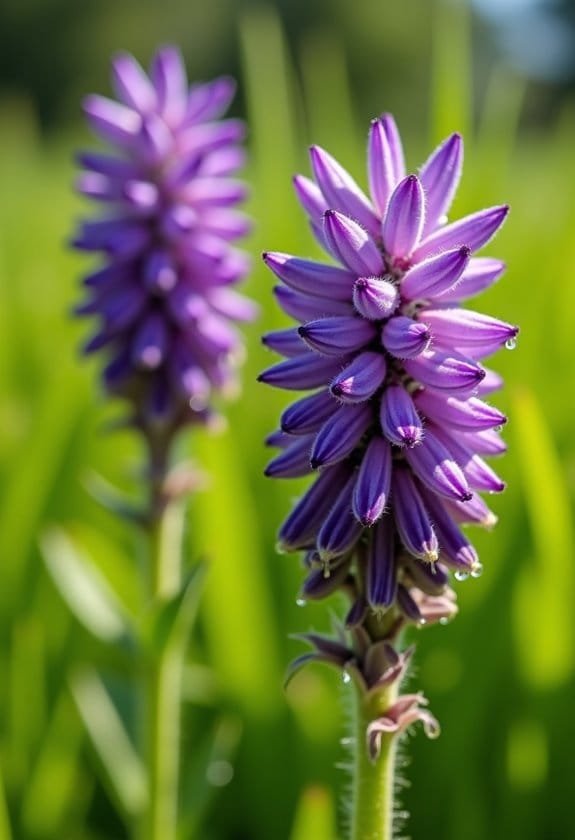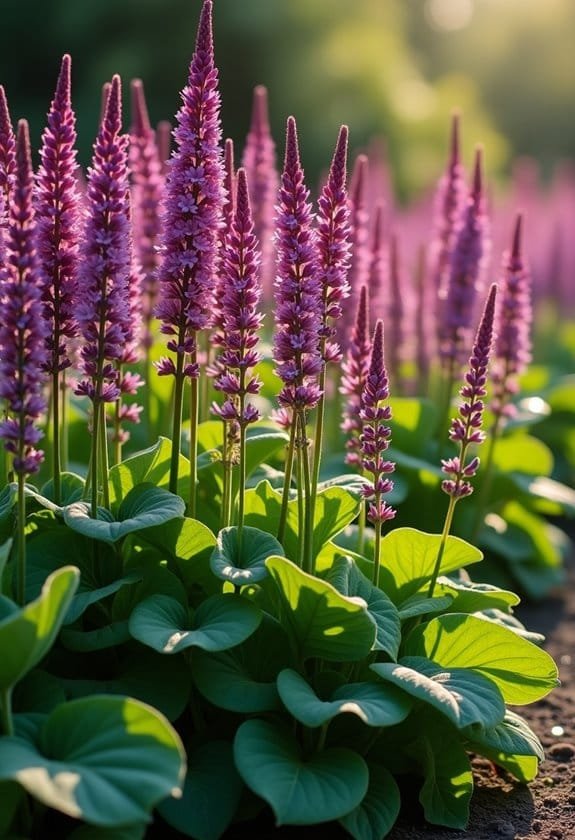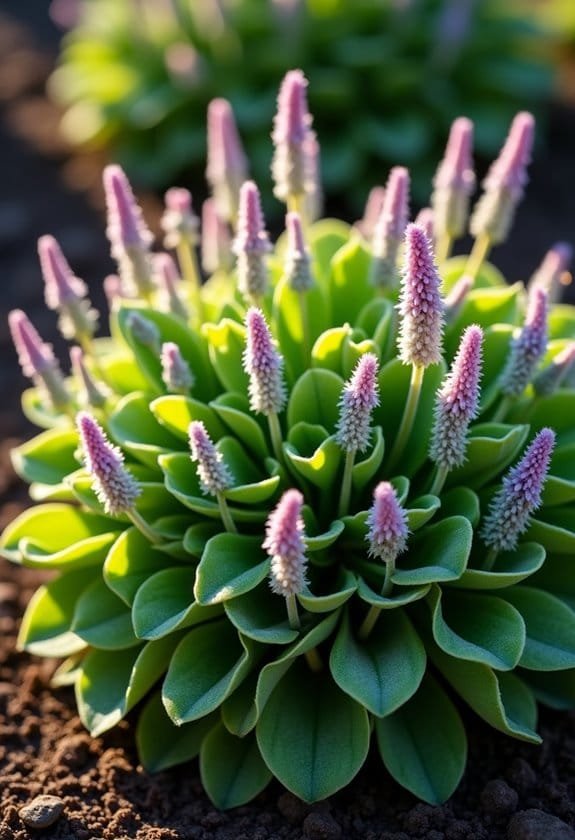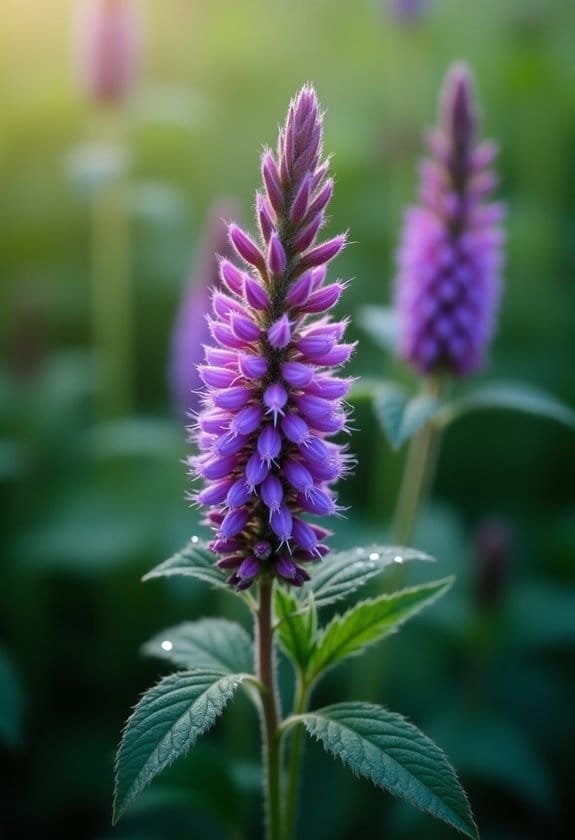Stachys macrantha, commonly referred to as Big Sage or big betony, is a resilient perennial that can reach heights of 1 to 3 feet, with flower spikes extending up to 24 inches. This visually striking plant showcases rich, bluish-violet blooms from late spring to early summer, thriving in well-drained soils and enjoying full sun to partial shade. Its heart-shaped, dark green foliage fosters biodiversity by attracting beneficial pollinators, including bees and butterflies. Easy to maintain, it requires minimal care while providing aesthetic and ecological benefits. By understanding its unique characteristics, gardeners can appreciate the full range of Big Sage's contributions.
Main Points
- Stachys macrantha, commonly known as Big Sage, is native to temperate regions and thrives in USDA Zones 3 to 7.
- It features attractive bluish-violet flower spikes that bloom from late spring to early summer, attracting pollinators like bees and butterflies.
- The plant prefers full sun to partial shade and requires well-drained soils with regular moisture while avoiding waterlogging.
- Big Sage is low-maintenance, making it ideal for novice gardeners, and it can serve as effective ground cover to suppress weeds.
- It enhances biodiversity by supporting local ecosystems and provides historical medicinal properties and culinary uses.
Introduction

Stachys macrantha, commonly known as Big Sage, showcases a remarkable adaptability in horticulture through its attractive features and beneficial properties.
This herbaceous forb, native to temperate regions, typically reaches heights of 1 to 3 feet and displays scalloped, dark green leaves that enhance its visual appeal in any garden setting.
Additionally, its ability to thrive in well-drained soils and moderate shade positions it as a versatile choice for both aesthetic and ecological purposes, promoting biodiversity while providing traditional herbal benefits.
Common Name
Known commonly as "Big Sage," Stachys macrantha captures attention with its sturdy presence and adaptability to a variety of growth conditions. This resilient perennial, part of the Labiatae family, thrives beautifully in full sun, withstanding the challenges posed by varied climates.
Characterized by its attractive bluish-violet flower spikes that bloom mid-summer, it enhances gardens with vibrant hues, attracting both pollinators and admirers alike.
Often referred to as big betony, Stachys macrantha is hardy in USDA Hardiness Zones 3 to 7, making it an ideal candidate for temperate landscapes. Its leaves display a lush green, complementing its colorful flowers, while its robust structure guarantees durability against environmental stresses.
Historically significant, Big Sage has roots in traditional herbal medicine practices, further emphasizing its multifaceted value beyond aesthetics.
Gardeners appreciate this species not just for its ornamental impact but also for its capacity to thrive with minimal care. Whether used as a border plant or a focal point, Stachys macrantha brings life and vibrancy to any setting, allowing nature to flourish in harmonious beauty.
Its resilience and charm guarantee it remains a favored choice for those seeking reliable, stunning landscape options.
Scientific Name
With its scientific designation of Stachys macrantha, Big Sage stands out in the botanical community. This member of the Labiatae family, which is renowned for its diverse array of species exceeding 3,000, often confounds horticulturists due to its common name suggesting a link to sage.
However, Stachys macrantha's dark green, slightly fuzzy foliage resembles that of lamb's ear, further enriching its ornamental appeal.
Native to temperate regions, this perennial thrives gracefully across USDA Hardiness Zones 3 to 7, showcasing its resilience in varied climates. Its most enchanting attribute is the striking bluish-violet flower spikes that rise above the lush foliage, attracting a multitude of pollinators, including bees and butterflies, which are crucial for ecological balance.
As a significant component of many gardens, Stachys macrantha not only enhances aesthetic value but also plays an instrumental role in supporting local biodiversity.
The plant adapts well to different environments, illustrating the importance of understanding its scientific classification for effective cultivation and conservation. In the domain of botany, recognizing the accurate designation allows enthusiasts to celebrate and promote the flourishing of such remarkable species.
Overview
Big Sage, or Stachys macrantha, offers an enchanting blend of beauty and utility in garden landscapes. This herbaceous forb thrives in temperate regions, typically reaching heights of 1 to 3 feet. Preferring well-drained soils and showing moderate shade tolerance, it flourishes across various growing zones, making it an adaptable choice for gardeners.
Blooming from late spring to early summer, Big Sage produces small, tubular flowers that not only captivate the eye but also attract a range of pollinators, enriching the wildlife habitat within the garden. Additionally, it plays a role in supporting local ecosystems, similar to the way Wild Thyme enhances biodiversity with its nectar-rich flowers.
Resilient and versatile, it tolerates poor soil conditions while necessitating regular moisture, so users must avoid waterlogging. Its clumping growth habit provides excellent ground cover, effectively suppressing weeds and promoting sustainable garden practices.
Additionally, Big Sage carries historical significance for its medicinal uses in traditional herbal remedies, providing another layer of value to this remarkable plant.
Key Features
Stachys macrantha, or Big Sage, showcases a remarkable growth size typically ranging from 1 to 3 feet, which allows it to stand out as a striking addition to garden landscapes.
With its dark green, heart-shaped leaves and unique bluish-violet flower spikes that emerge from late spring to early summer, this herbaceous forb enchants both the eye and the spirit.
Its adaptability to various garden conditions, particularly well-drained soils and a preference for full sun to partial shade, guarantees that it thrives vigorously, enhancing both beauty and biodiversity in any setting.
Growth Size
One can expect Stachys macrantha, or Big Betony, to typically reach a height of 12-18 inches, displaying a lush clumping habit. These growth characteristics contribute to its appeal in various garden settings, where size comparisons often highlight its moderate stature relative to other mint family members.
While its basal foliage remains at this preferred height, it's crucial to recognize that the bluish-violet flower spikes emerging in mid-summer can reach impressive heights of 18 to 24 inches. Such height variations enhance the plant's visual interest, as the heights of flower spikes soar above the lush, scalloped foliage.
The dark green leaves, larger than those of many mint varieties, not only add to its attractiveness but also underscore how adaptable this species can be in varying soil conditions.
Big Betony spreads gradually across gardens, positioning itself as a non-invasive alternative to more aggressive mint relatives. This gradual spread allows gardeners to enjoy the plant's beauty without the concern of overwhelming their landscapes.
Appearance
This striking perennial plant is defined by its clumping habit and lush foliage, typically reaching heights between 12 to 18 inches. Stachys macrantha, commonly known as big sage, showcases dark green, heart-shaped leaves that exhibit a distinctive scalloped edge. These leaves are larger than most varieties belonging to the mint family, providing a rich, textured appearance that contrasts beautifully with its surroundings.
Its stems are square-shaped, a characteristic trait of the mint family, and lend structural support to numerous botanical wonders. While the plant is primarily recognized for its stunning flower spikes, which bloom in mid-summer, its overall appearance is equally engaging.
The lush, vibrant foliage can adapt to various habitat preferences, thriving in well-drained soils with partial to full sunlight. Color variations may appear as deep greens or lighter shades depending on environmental factors, but generally, the consistently rich green tones enhance its visual appeal.
In essence, big sage enthralls with its robust leaf texture and unique form, making it a remarkable choice for gardens aiming to showcase resilient and visually engaging flora.
Flowering Season
A vibrant display of bluish-violet flower spikes characterizes the flowering season of Stachys macrantha, commonly known as Big Sage. Typically, this striking plant blooms from late spring to early summer, with its flowering duration reaching a peak in June and early July.
These elegant flower spikes, which can grow between 18 to 24 inches in height, feature small, two-lipped tubular flowers. This distinctive structure adds both charm and character to gardens, making it an ornamental favorite.
The flowering season serves a significant ecological role, promoting pollinator attraction that includes essential species like bees and butterflies. These visitors not only enhance the beauty of the garden but also contribute to the critical processes of pollination, which supports overall biodiversity.
To guarantee ongoing vitality, seasonal maintenance becomes essential; gardeners should regularly remove spent flowers in late fall, a practice that encourages healthier growth and prepares the plant for the following season.
Growing Requirements

Stachys macrantha's growing requirements fundamentally influence its health and vigor.
Preferring well-drained soils and basking in full sun to partial shade, this resilient plant flourishes best in conditions where its specific light and moisture needs are met.
Light
Stachys macrantha (Big Sage) thrives in full sun to partial shade, showcasing its versatility in garden settings. This remarkable plant demonstrates specific light preferences that greatly impact its growth and flowering. Ideally, it needs at least six hours of direct sunlight daily to achieve vigorous growth and abundant blooms during the growing season.
Though Big Sage exhibits impressive light adaptation, prolonged exposure to deep shade can stifle its flowering potential and overall liveliness.
In gardens characterized by scorching summer temperatures, incorporating partial shade, particularly during the afternoon, acts as a protective barrier against heat stress. This strategic shading not only preserves the plant's vigor but also enhances its resilience.
The light benefits provided through ideal sunlight exposure extend beyond mere aesthetics; they guarantee robust photosynthetic activity, essential for nutrient production and energy flow.
Moreover, effective light management is crucial in preventing conditions that may lead to disease and rot, which are prevalent in environments with excessive moisture.
However, it's paramount to remember that while Stachys macrantha can adapt to various light conditions, excessive moisture coupled with low light levels creates an environment ripe for disease and rot.
Therefore, careful attention to light conditions can make a considerable difference, leading to a flourishing plant that enriches any garden space.
Soil
Growing Stachys macrantha requires attention to soil conditions, as this plant flourishes in well-drained soils that prevent root rot and support healthy development.
Ideally, the soil should be a mix of clay, loam, and sandy textures, providing versatility and adaptability. While Stachys macrantha can endure less-than-ideal conditions, incorporating soil amendments such as compost or organic matter can markedly enhance its resilience and growth potential.
To optimize growth, gardeners should implement effective drainage techniques, guaranteeing that the soil retains adequate moisture without becoming overly saturated. This delicate balance is vital, as prolonged waterlogged conditions can quickly lead to detrimental root rot.
In addition, maintaining a soil pH between 6.0 and 7.0 guarantees that essential nutrients remain available to the plant, promoting lush foliage and vibrant blooms.
Regular pH balancing through simple testing can make a world of difference; understanding the soil's composition allows for tailored adjustments over time.
Attention to these details not only fosters a thriving environment for Stachys macrantha but also enhances the overall health of the garden ecosystem, creating a harmonious interaction with surrounding plants and soil.
Water
Providing adequate water is indispensable for the success of Stachys macrantha in any garden. This perennial plant prefers well-drained soils and doesn't thrive in overly moist conditions, making it suitable for drier environments. To achieve optimal growth, gardeners should implement appropriate watering techniques that guarantee consistent hydration during the growing season, particularly focusing on moisture management.
While Stachys macrantha can tolerate periods of drought once established, regular watering during dry spells is essential to promote healthier growth and vibrant blooms. It's critical to avoid waterlogged soil, as it can lead to root rot, a common concern for this species. A layer of mulch can enhance soil moisture retention while simultaneously suppressing weeds that compete for important nutrients. Additionally, understanding the plant's need for consistent moisture levels in its growing environment is crucial for its overall health.
Balancing moisture levels is paramount; achieving this delicate equilibrium helps the plant flourish beautifully. Gardeners can achieve this by monitoring soil dryness and adjusting their watering frequency accordingly. Water Avens also shares a preference for moisture-rich environments, which demonstrates the importance of understanding individual plant needs in the garden.
With a little diligence, Stachys macrantha can demonstrate remarkable drought resilience, thriving without excessive care and enchanting all who encounter its stunning foliage and flowers. By understanding and respecting these water requirements, gardeners can cultivate success with this charming species.
Temperature
Understanding temperature requirements is vital for the successful cultivation of Stachys macrantha. This hardy plant flourishes in USDA Hardiness Zone 3, enabling it to endure winter temperatures as low as -40°F (-40°C), showcasing impressive temperature tolerance.
During the growing season, it thrives best amid moderate to warm conditions, ideally between 60°F and 75°F (15°C to 24°C). Although Stachys macrantha favors full sun, it can also adapt to partial shade, providing flexibility in garden placement.
While the plant can withstand short periods of heat above 90°F (32°C), it's essential to guarantee adequate moisture during these temperature extremes to mitigate stress and promote healthy growth.
Additionally, Stachys macrantha's ability to cope with temperature fluctuations is enhanced by well-drained soils, which help maintain a stable environment around the root system. This stability not only supports overall growth but also fosters resilience against environmental stressors.
Pollinator Criteria
Stachys macrantha's vibrant bluish-violet flowers not only captivate the eye but also attract a diverse array of pollinators, particularly bees and butterflies, which are essential for successful pollination.
The two-lipped, tubular structure of its blooms allows for easy access, facilitating the efficient foraging behaviors of these beneficial insects. Additionally, similar to Sea Campion's role in supporting coastal biodiversity, Stachys macrantha enhances ecosystem health by providing nutrients for native plant growth and attracting various insects. Furthermore, these flowers, akin to the characteristics of Echium vulgare, serve as a vital resource for pollinators in a range of environments.
Attracted Pollinators
Numerous pollinators are drawn to Stachys macrantha, also known as Big Betony, thanks to its rich nectar and tubular flowers. This perennial plant, blooming from late spring to early summer, offers an essential early-season food source for bees, butterflies, and moths emerging from winter slumber.
Pollinator preferences play a significant role in determining which species frequent Stachys macrantha; for instance, bumblebees exhibit a strong attraction to its bluish-violet flower spikes, where they find ideal foraging opportunities.
In addition to providing sustenance, the aromatic foliage of this mint family member helps cultivate additional herbivore-friendly insects, further bolstering pollinator populations. Nitrogen-fixing capabilities of nearby plants like Common Restharrow can also enhance soil health, providing a richer environment for these pollinators.
These insects often seek nesting habitats close to flowering plants, establishing a beneficial cycle of life that features interconnected relationships within local ecosystems.
Pollination Method
Among the various factors influencing the pollination of Stachys macrantha, the flower's unique structure plays a vital role in attracting specific pollinators. The two-lipped blooms, which resemble small tubes, are perfectly adapted to facilitate access for long-tongued bees and butterflies, ensuring effective pollen transfer. This adaptation is significant, as the plant relies heavily on cross-pollination importance to produce viable seeds for the next generation. Additionally, like *Geum rivale*, Stachys macrantha is highly valued for its role in promoting local biodiversity and ecosystem stability.
Blooming from late spring to early summer, Stachys macrantha aligns its flowering period with the peak activity of local pollinators, increasing the likelihood of successful pollination events. The nectar availability strategies employed by this plant further entice pollinators, creating an inviting buffet that enhances its reproductive success. Moreover, similar to Lonicera periclymenum(Common Honeysuckle), Stachys macrantha not only provides food resources but also contributes to a healthy environment for various wildlife species.
Consequently, the flower's intricate adaptations not only promote cross-pollination but also contribute to the plant's vital role in supporting local biodiversity.
By offering essential resources such as food and habitat, Stachys macrantha nurtures a range of pollinators throughout its blooming season, thereby ensuring a thriving ecosystem.
Fundamentally, the marriage of flower structure and pollinator behavior exemplifies nature's elegance and complexity.
Care & Maintenance

When considering the care and maintenance of Stachys macrantha, proper planting techniques form the foundation of ideal growth.
Ongoing care involves regular activities such as removing spent blooms and ensuring adequate spacing of 18 to 24 inches for better air circulation.
Additionally, selecting suitable companions can enhance both the plant's aesthetics and its overall health in a garden setting.
Planting Tips
Planting Stachys macrantha, commonly known as Big Sage, requires careful consideration for best growth and flowering. To achieve peak results, gardeners should focus on soil preparation, guaranteeing it's well-drained and enriched with organic matter to bolster sustenance.
Ideally, Big Sage thrives in full sun to partial shade, as adequate light encourages vibrant blooms and sturdy growth.
Utilizing effective planting techniques is significant. When engaging in seasonal planting, early spring is the prime time for establishing new clumps; spacing them 18 to 24 inches apart allows for adequate air circulation, which mitigates the risk of diseases.
Gardeners should also remain vigilant for slugs and common garden nuisances, promoting a thriving environment for the Big Sage.
Consistent watering is imperative, but avoid waterlogged conditions, as soggy soil can inhibit root development and robustness. During dry periods, sustaining soil moisture enhances the plant's resilience and confirms continued blooming. Additionally, practicing proper drainage is crucial to prevent root deterioration and ensure the plant's health.
To streamline future growth, promptly remove spent blooms and dead foliage by late fall, encouraging rejuvenation for the following year.
Through these considerate practices, the gardener will foster a lush and healthy display of Stachys macrantha, enriching their garden landscape with its unique charm.
Ongoing Care
Caring for Stachys macrantha, or Big Sage, is straightforward and rewarding. To maintain its vibrant appearance, gardeners should focus on seasonal adjustments during the late fall, removing spent blooms and dead growth. Implementing effective pruning techniques can also promote continued flowering throughout the growing season, ensuring the plant remains fresh and visually appealing.
Early spring presents an ideal time for division of clumps when new growth is evident, allowing for proper spacing of 18 to 24 inches between plants to optimize growth conditions. Regular watering is crucial, and while Stachys macrantha is significantly resistant to diseases, insects, rabbits, and slugs, consistent nutrient management through balanced fertilizer recommendations will bolster its health.
It's essential to provide a sunny location with well-drained soil, as waterlogged conditions can adversely affect the plant's vitality. By adhering to these basic maintenance strategies, gardeners will cultivate an attractive landscape, utilizing Stachys macrantha's robust nature.
Ultimately, with minimal effort, one can experience the joy of nurturing a resilient plant that not only enriches outdoor spaces but also promotes biodiversity in the garden.
Suggested Companions
Pairing Stachys macrantha with complementary plants enhances both aesthetics and resilience in the garden. This hardy perennial thrives in clusters, making it an ideal partner for drought-tolerant varieties like Salvia and yarrow. Such seasonal pairings not only create vibrant, colorful combinations but also help establish a garden that withstands dry spells.
Integrating Shasta daisies into the landscape produces striking textural contrasts; their bright summer blooms align beautifully with the mid-summer flowering of Stachys macrantha's mauve flowers. This thoughtful selection fosters an engaging visual narrative throughout the growing season. Additionally, Stachys macrantha's rooting stolons can help it effectively compete for space.
To maintain a healthy garden, regular care is essential. Deadheading spent blooms after they fade encourages a tidy appearance and curtails self-seeding, typically performed in late summer.
Moreover, dividing Stachys macrantha every few years in early spring promotes vigorous growth while managing its spread.
Spacing plants 18 to 24 inches apart allows them adequate room to thrive and discourages overcrowding.
With well-drained soil and adaptability to full sun or partial shade, Stachys macrantha serves as a versatile backbone for any garden, blooming alongside its carefully chosen partners to create an enchanting landscape. Additionally, incorporating plants like Blue Eryngo can enhance pollinator support in your garden, attracting beneficial insects essential for ecosystem health.
Common Issues
While Stachys macrantha is generally resilient, it isn't completely free from common issues that gardeners may encounter.
Overwatering poses a significant risk, as it can lead to root rot, which disrupts the plant's stability and overall health. To prevent this, it's essential to ensure well-draining conditions, similar to those preferred by other plants in the Apiaceae family.
Additionally, the potential for powdery mildew in humid conditions highlights the importance of proper spacing and sunlight exposure to curb diseases and enhance growth. Frequent monitoring of plant vigor can also help detect early signs of these issues before they escalate.
Pests/Diseases
Often regarded as a resilient plant, Stachys macrantha (Big Sage) typically faces few pest and disease challenges in the garden. However, vigilant gardeners may encounter some common issues, primarily due to environmental stressors.
Aphids and spider mites can occasionally invade, especially in unmonitored situations. It's crucial to employ pest management strategies, such as regular inspections of foliage and, if necessary, the application of insecticidal soap to curb infestations without harming beneficial insects.
Fungal diseases, particularly root rot, thrive in overly moist conditions, underscoring the importance of well-drained soil for ideal plant health. Moreover, Dark Mullein's ability to thrive in well-draining soil reinforces the necessity of proper drainage to prevent similar issues. Meanwhile, humidity can lead to leaf spot diseases that compromise aesthetics; implementing disease prevention techniques, including adequate spacing and ensuring good air circulation, can mitigate these threats markedly.
Additionally, maintaining plant vigor throughout the growing season entails regularly removing damaged or dead foliage. This simple yet effective practice helps prevent disease spread, maintaining a visually appealing garden space.
Understanding organic control methods proves advantageous when combating pests and diseases, offering eco-friendly approaches that safeguard the well-being of the plant and its surrounding environment. Moreover, regular monitoring for root rot can help prevent issues that affect plant vitality. By focusing on these aspects, gardeners can cultivate thriving Stachys macrantha plants with minimal struggle.
Solutions
Solutions for common issues with Stachys macrantha start with understanding its fundamental needs. This remarkable plant thrives in well-drained soils, essential for preventing root rot caused by excessive moisture.
Gardeners should engage in sustainable gardening practices by monitoring soil health; this promotes not only the plant's vigor but also the surrounding ecosystem. Regular deadheading of spent flowers encourages prolonged blooming, preventing unnecessary self-seeding, which can clutter desired spaces. Moreover, ensuring proper soil drainage is crucial for the health of various plants in the garden.
To manage the plant's spread, dividing it every few years, particularly in early spring, is advisable. Maintaining an 18 to 24-inch spacing between clumps fosters an inviting wildlife habitat, allowing pollinators and beneficial insects to flourish without overcrowding.
Additionally, while Stachys macrantha exhibits drought tolerance, consistent hydration during dry spells greatly enhances its health and blooming performance, ensuring vibrant displays. Furthermore, companion planting with flowering perennials can attract pollinators and help maintain a balanced ecosystem within the garden.
Summary

Stachys macrantha, commonly known as big sage, is a hardy herbaceous forb native to temperate regions and part of the mint family, Labiatae. This resilient plant typically grows in clumps, reaching heights of 1 to 3 feet, and thrives in well-drained soils with moderate shade tolerance. Its enchanting rosy-mauve blooms grace gardens from late spring to early summer, attracting pollinators and enhancing biodiversity.
The cultural significance of big sage extends throughout history, characterized by its medicinal properties and culinary uses. Traditionally, various parts of Stachys macrantha have been employed in herbal remedies, believed to alleviate certain ailments. Additionally, its edible components seamlessly blend into diets, adding unique flavors and nutritional benefits.
Furthermore, big sage serves a practical purpose in gardens by providing excellent ground cover that helps suppress intrusive weeds while showing remarkable adaptability to diverse environmental conditions. As gardeners seek to create sustainable landscapes, the inclusion of Stachys macrantha not only beautifies spaces but enriches local ecosystems, emphasizing its multifaceted value.


